
Pierre-Joseph Redouté, was a painter and botanist from Belgium, known for his watercolours of roses, lilies and other flowers at the Château de Malmaison, many of which were published as large, coloured stipple engravings. He was nicknamed "the Raphael of flowers" and has been called the greatest botanical illustrator of all time.

Haemodoraceae is a family of perennial herbaceous flowering plants with 14 genera and 102 known species. It is sometimes known as the "bloodwort family". Primarily a Southern Hemisphere family, they are found in South Africa, Australia and New Guinea, and in the Americas. Perhaps the best known are the widely cultivated and unusual kangaroo paws from Australia, of the two closely related genera Anigozanthos and Macropidia.

Anigozanthos is a genus of Southwest Australian plants of the bloodwort family Haemodoraceae. The 11 species and their subspecies are commonly known as kangaroo paw or catspaw, depending on their size, and the shape and color of their flowers. A further species, previously identified as Anigozanthos fuliginosus, was separated to a monotypic genus as Macropidia fuliginosa.

Kangaroo paw is the common name for a number of species, in two genera of the family Haemodoraceae, that are native to the south-west of Western Australia. These rhizomatous perennial plants are noted for their unique bird-attracting flowers. The tubular flowers are coated with dense hairs and open at the apex with six claw-like structures which resemble kangaroo forelimbs, and it is from this paw-like formation that the common name "kangaroo paw" is derived.

Anigozanthos manglesii, commonly known as the red-and-green kangaroo paw, Mangles' kangaroo paw, Kurulbrang (Noongar), is a plant species endemic to Western Australia, and the floral emblem of that state.
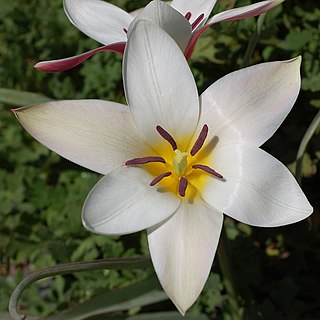
Tulipa clusiana, the lady tulip, is an Asian species of tulip native to Afghanistan, Iran, Iraq, Pakistan and the western Himalayas. It is widely cultivated as an ornamental and is reportedly naturalized in France, Spain, Portugal, Italy, Tunisia, Greece, and Turkey.
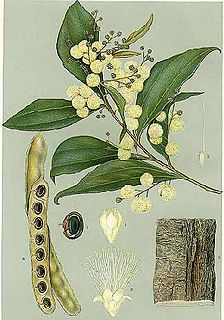
Acacia binervata, commonly known as two-veined hickory, is a shrub or tree that is endemic to eastern Australia.

Macropidia fuliginosa, the sole species of genus Macropidia, is a perennial rhizomatous flowering plant. A relation of the kangaroo paws, Anigozanthus, which are also endemic to Southwest Australia, it is referred to as the black kangaroo paw. Bearing unusual black and green flowers, it occurs on a coastal plain from Perth to Geraldton.

Corymborkis, commonly known as cinnamon orchids, or 管花兰属 is a genus of eight species of orchids in the family Orchidaceae. They are evergreen, terrestrial plants which grow in clumps and have thin roots, leafy stems, pleated leaves and widely-opening flowers with thin, spreading sepals and petals. They are widely distributed in the tropics.
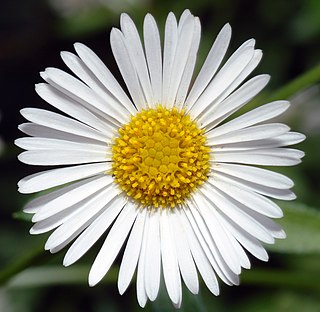
Erigeron karvinskianus, the Mexican fleabane, is a species of daisy-like flowering plant in the family Asteraceae, native to Mexico and parts of Central America.

Conostylis is a genus of perennial herbs in the Haemodoraceae family, commonly known as cone flowers. All species are endemic to the south west of Western Australia.
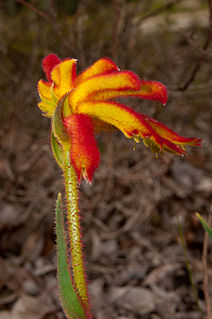
Anigozanthos humilis is a species of Anigozanthos in the family Haemodoraceae. This flowering perennial plant is endemic to Southwest Australia and widespread in its open forests. Common names include catspaw and common catspaw.
Anigozanthos preissii, the Albany cat's paw, is a herbaceous plant species in the family Haemodoraceae, endemic to Western Australia.

Persoonia linearis, commonly known as the narrow-leaved geebung, is a shrub native to New South Wales and Victoria in eastern Australia. It reaches 3 m (9.8 ft), or occasionally 5 m (16 ft), in height and has thick, dark grey papery bark. The leaves are, as the species name suggests, more or less linear in shape, and are up to 9 cm (3.5 in) long, and 0.1 to 0.7 cm wide. The small yellow flowers appear in summer, autumn and early winter, followed by small green fleshy fruit known as drupes. Within the genus Persoonia, it is a member of the Lanceolata group of 58 closely related species. P. linearis interbreeds with several other species where they grow together.
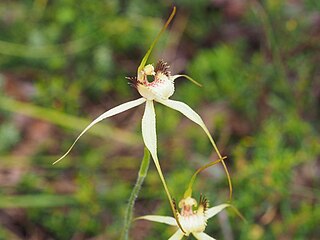
Caladenia busselliana, commonly known as Bussell's spider orchid, is a plant in the orchid family Orchidaceae and is endemic to a small area in the south-west of Western Australia. It is a rare orchid with an erect, hairy leaf and up to three pale yellow flowers. Only about fifty specimens are known and it is threatened by habitat destruction and by too-frequent or too infrequent bushfires.

Anigozanthos gabrielae is a species of Anigozanthos in the family Haemodoraceae known as dwarf kangaroo paw. This flowering, rhizomatous, perennial plant is endemic to Southwest Australia and grows on sand in areas which are wet in winter.

Anigozanthos rufus is a grass-like evergreen perennial plant native to the southern coasts of Western Australia. Common names include red kangaroo paw, crimson kangaroo paw, and backdraft.

Anigozanthos viridis, commonly known as Green Kangaroo Paw, is a grass-like perennial herb native to south western coastal regions of Western Australia. The Noongar peoples know the plant as Koroylbardany.

Anigozanthos bicolor, commonly known as little kangaroo paw or two coloured kangaroo paw, is a grass-like perennial herb native to the south western coastal parts of Western Australia.
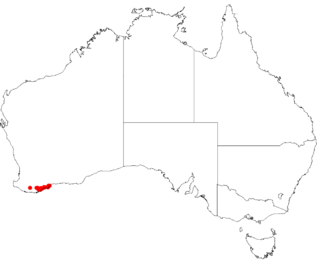
Anigozanthos onycis, the branched catspaw, is a rarely seen plant found in Southwest Australia.





















